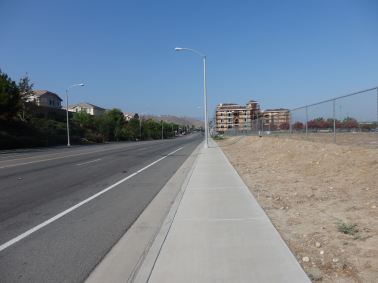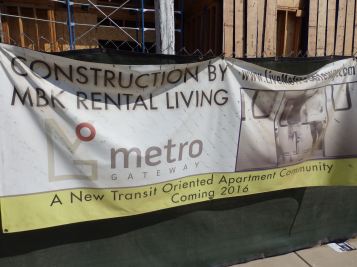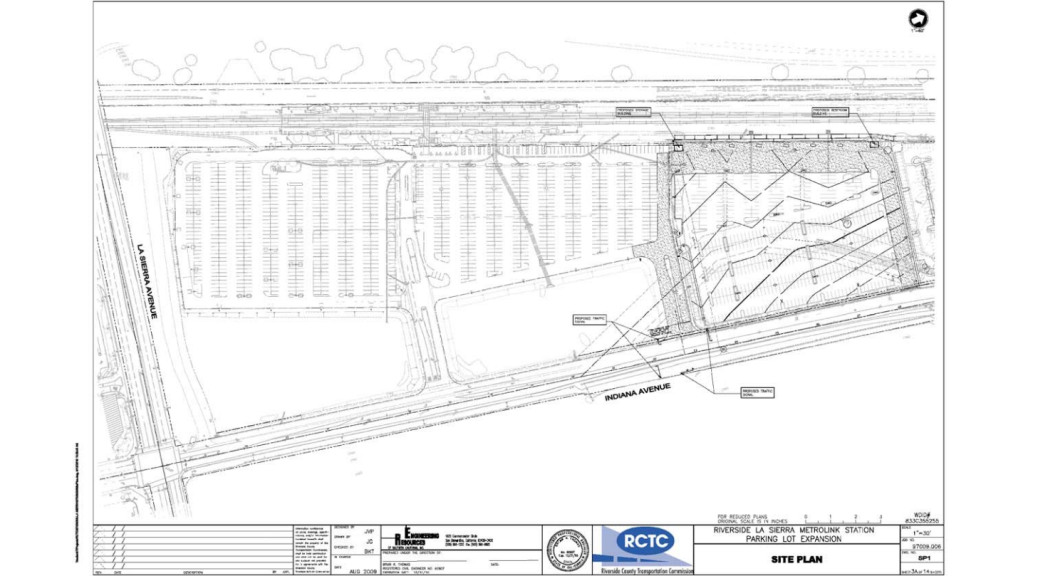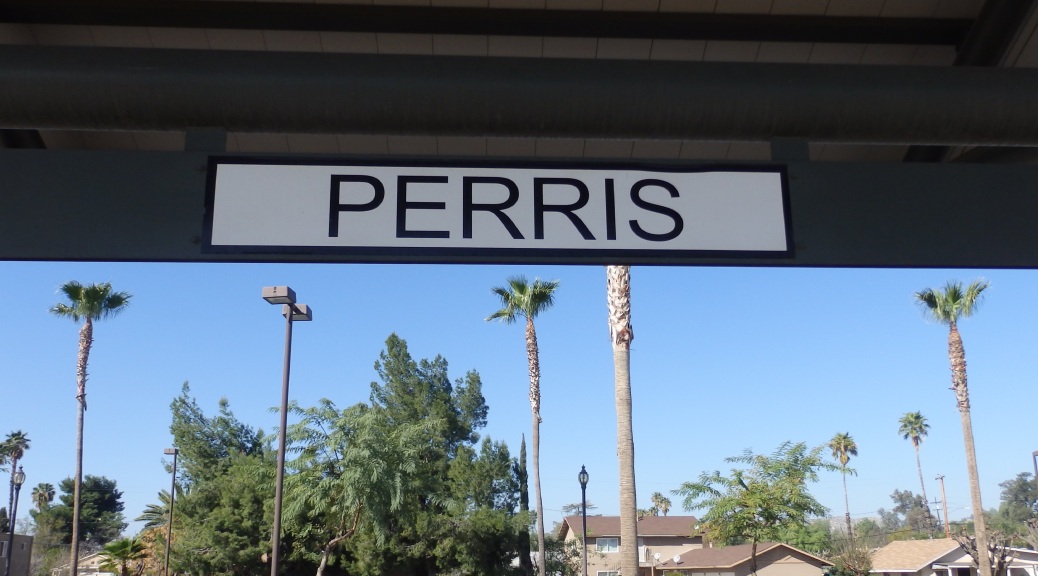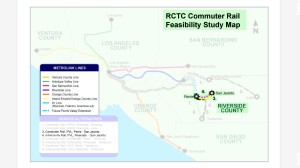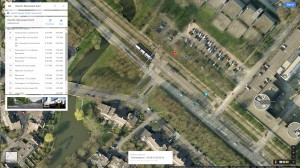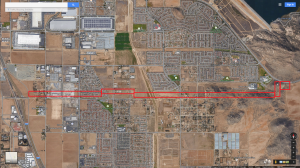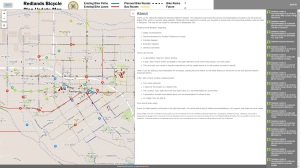Things are ever so slowly coming together on SoCal’s biggest rail expansion of the year: Metrolink’s Perris Valley Line. The Riverside County Transportation Commission is leading the project that will add a hair over 24 miles and four more stations to the Metrolink system, an undertaking that has been in the works for decades. RCTC originally purchased the San Jacinto Branch Line being used for the extension back in 1993. They’ve sat on it since then, largely content with limiting their rail ambitions to numerous studies of all the options. However, BNSF does still service some customers along the subdivision and the portion through Moreno Valley is where some freight cars got blown over a couple years back.
Trains were originally supposed to be rolling by the end of 2015. And they were, with RCTC holding an opening ceremony back in December. Unfortunately, nearly a quarter of the way into 2016, those rolling trains still are not carrying passengers. Though trains have been running tests since October, there are still varying levels of construction continuing at all the stations; the Downtown Perris station is probably the most put together of the lot. This presents another setback for a project that has already seen it’s share of delays from studies and a NIMBY lawsuit.
In traditional suburban commuter rail fashion, all four stations are surrounded by a moat of parking, with probably at least 1,100 spaces spread among them. This is ultimately not surprising, especially since RCTC is currently embarking on a parking lot expansion at the La Sierra station, but it remains to be seen if this is really the best plan in the long term. The good part about parking is that it can be easily converted to something else and since it is already provided, perhaps the communities where they’re located will be able to leverage them to meet minimum requirements. Nevertheless, let’s have a quick glance at what has been built thus far.
South Perris
The South Perris Station is the end-of-the-line for the current extension, but the rail corridor is the one that would eventually continue on to San Jacinto if RCTC doesn’t kill it first. But since it is the current end, this site consists of not just a platform and parking lot, but several tracks for layovers and overnight storage of the trainsets. Everything at this site is still under construction including the layover yard, the parking lot, and the boarding platform. It’s probably not an understatement to say that this is the least complete of the bunch. Totally surrounded by farmland, this station is (obviously) largely designed to capture park-n-riders from places like Menifee, French Valley, and even Hemet. However, the literal absence of anything built immediately adjacent to it does provide a great opportunity for the City of Perris to leverage the transit connection to direct development there in the future. But with both an airport and sewage treatment plant nearby, there is certainly room to discuss whether residential would be the best type of development for the location.
Downtown Perris
In a direct contrast to the So. Perris station, the Downtown Perris station is probably the most complete of the four. It’s not just a stop for Metrolink, but also the hub for RTA’s operations in the area and the bus bays are already seeing use. It is located in the center of Perris directly adjacent the historic Sante Fe depot in the city and the tracks from the Orange Empire Railway Museum are being extended to provide access directly from the train station and the station itself has several very prominently featured memorials to the late Disney animator Ward Kimball.
Though this station is also surrounded by a moat of parking directly adjacent the station, there is one mixed-use development across from the station with several dozen apartments as well as some City offices occupying some of the retail spaces. Other spaces are still vacant, but that will probably change soon, especially once trains are running. There are also quite a few vacant lots in close proximity to the station and with UCR just two stops away, I wouldn’t be surprised to see some renewed interest from developers. Already, some affordable units within a half mile of the station have recently been completed and more are probably going to be on the way.
At the station itself, the pedestrian accommodations are a refreshing to see in a region that critically lacks any such provisions. However, the ped and bike connections to access the site could do with some improvement. Most egregious is likely the intersection directly adjacent the station block, where pedestrian crossing is prohibited on the leg of the intersection closest the station. Predictably, that manifested itself by way of an elderly gentleman crossing CA-74 at the rail crossing. Additionally, RCTC has unfortunately not gotten the memo on good bike parking and installed ‘wave’ racks at the station itself.
Alessandro
The Alessandro station is another primarily commuter-focused station. Since the likely ridership will come from Moreno Valley and the eastern side of Riverside, its major component is also a couple acres of blacktop to allow people to store their cars. It’s surrounded not by farmland, but by warehouses and there are a couple of vacant lots nearby too. There is also an office building or two directly adjacent the station, but it remains to be seen if the reverse commute will actually go all the way to Perris and thus be useful enough to draw ridership to use it. Additionally, there are several pads on the station site itself with signs stating their availability for building as well as empty lots across the street. Similar to South Perris, it also presents a great opportunity to take advantage of the budding transit potential with some smart development, especially given the relative proximity to the Alessandro BRT project currently being planned.
Hunter Park/UCR
At the time of stop by, the Hunter Park/UCR station was probably the second most ready for use. This station is also primarily a park-and-ride lot located in the midst of warehouses. Unfortunately, the same NIMBYs who delayed the train were also successful in stopping plans for a station that was to be more proximate to UCR itself and which could’ve provided a great anchor point for the Riverside Reconnects streetcar. It has been rumored that the station might still be built in the future, but that is a long way off from reality at the moment. The station that did get built is directly adjacent the UCR Bourne School of Engineering Annex, about a mile and a half from the main campus. Fortunately, RCTC took the forward-thinking step of ensuring that the sidewalk from the platform extended to both sides of the block where the station is located, providing a convenient cut-through of what is otherwise a half-mile long block.
This is also the most northern station and the last of the four new ones when heading west on the line. Much like the Downtown Perris station, it will be a hub for buses in the area and includes a bus-only loading zone. Since the station isn’t actually on the campus, hopefully UCR will run a shuttle to meet the trains and provide students that connection. There are also some vacant lot opportunities directly across the street that are available, hopefully the City of Riverside can guide development to those areas. Given the proximity to the school, student housing probably would be best, especially since the population generally owns fewer cars anyway. But other types of housing shouldn’t be shunned, especially since it will be one station away from downtown Riverside.
A handy feature of both the HP/UCR and Alessandro stations is their use of bioswales for onsite water management. That’s a refreshing change from the status quo in the vast majority of parking lots that rely on funneling water into gutters and drainage systems. Every bit of water that we can not send down the river soon as it hits the ground is beneficial to a region that is still in a drought. Such seemingly little things can have a big impact and hopefully this is indicative of a new approach to water management.
That’s it for now. At a future date (likely after service begins), I’ll take the time to delve into each station individually. Meanwhile, many pictures of the current state are available here.
